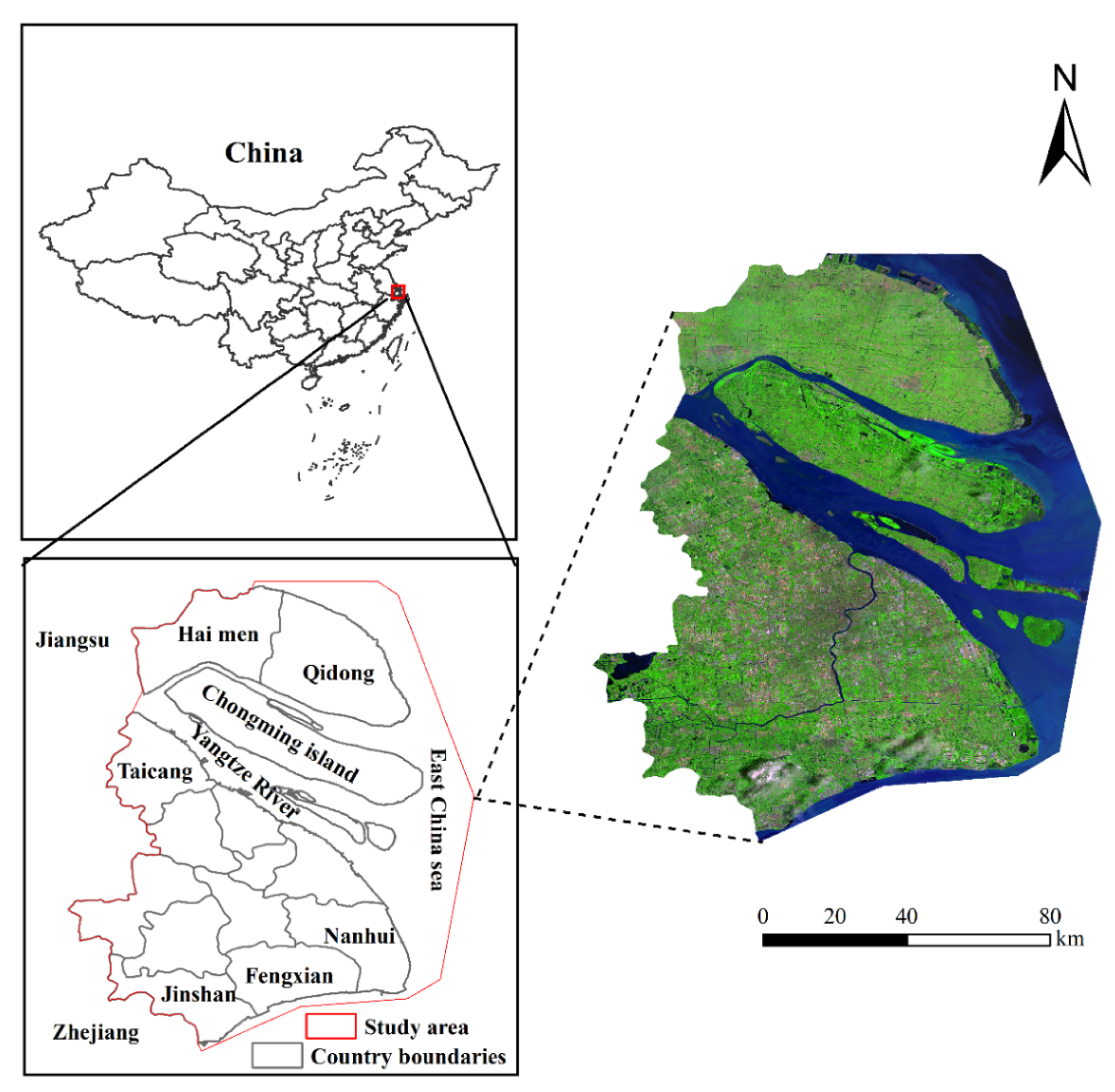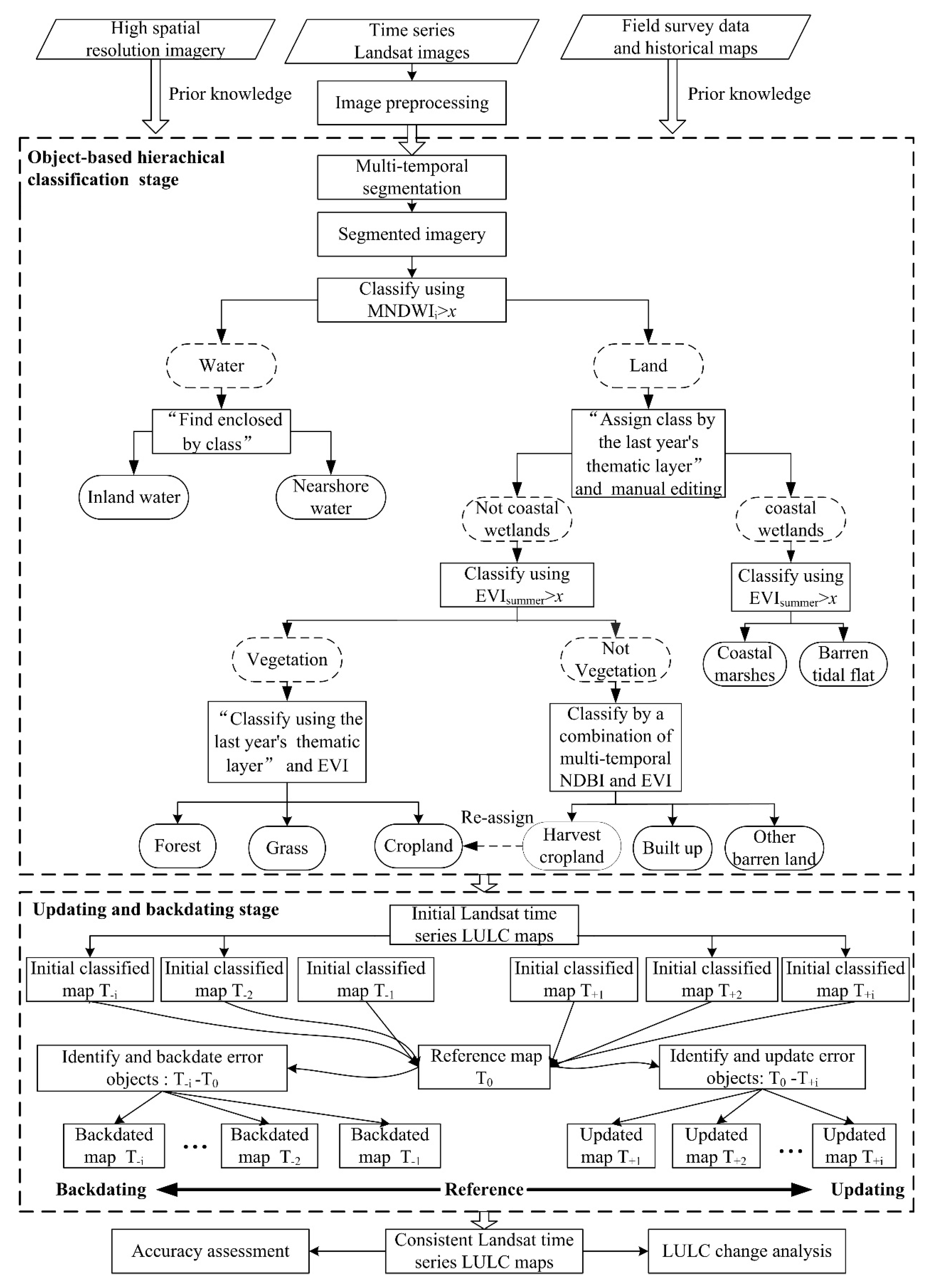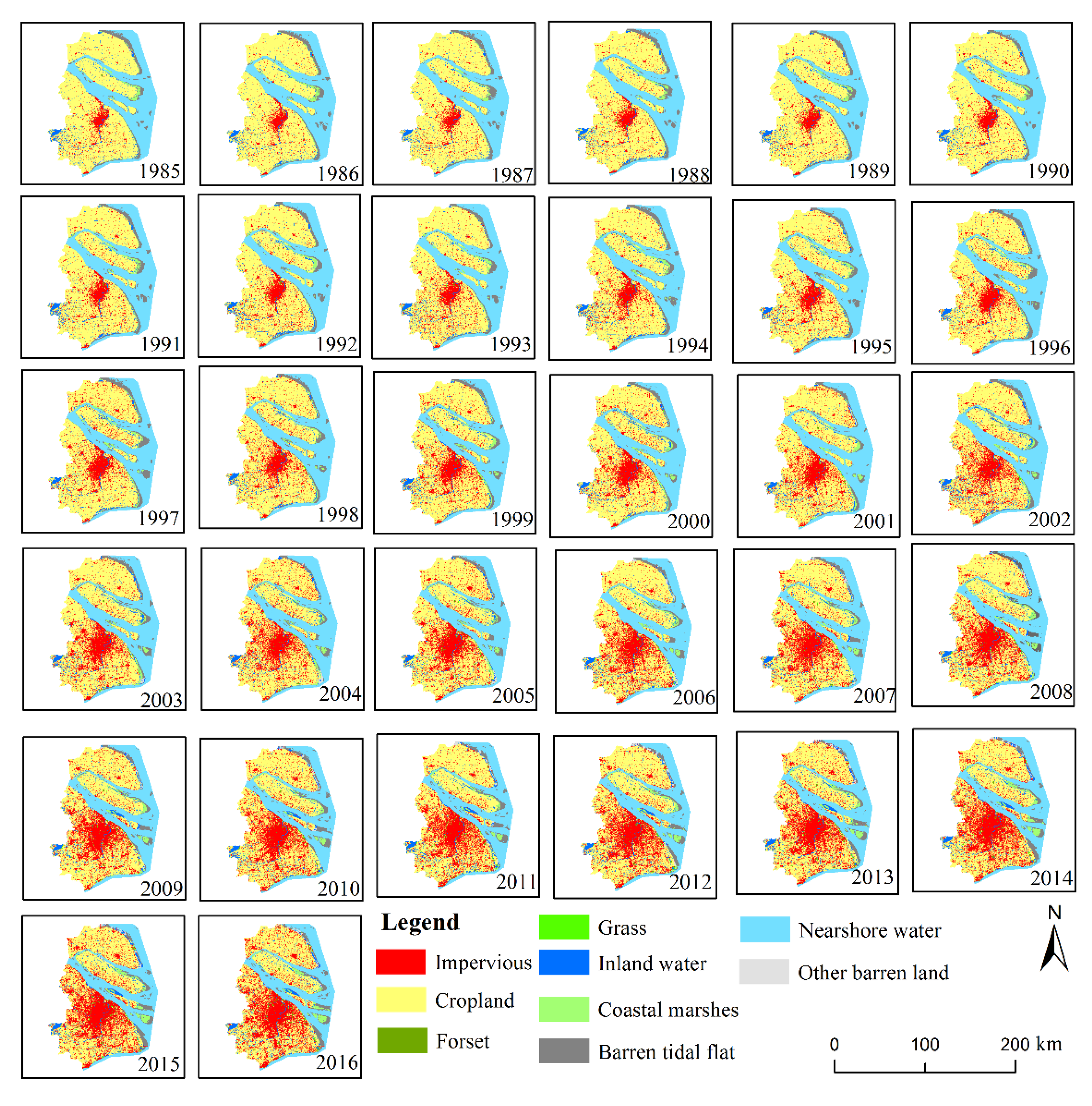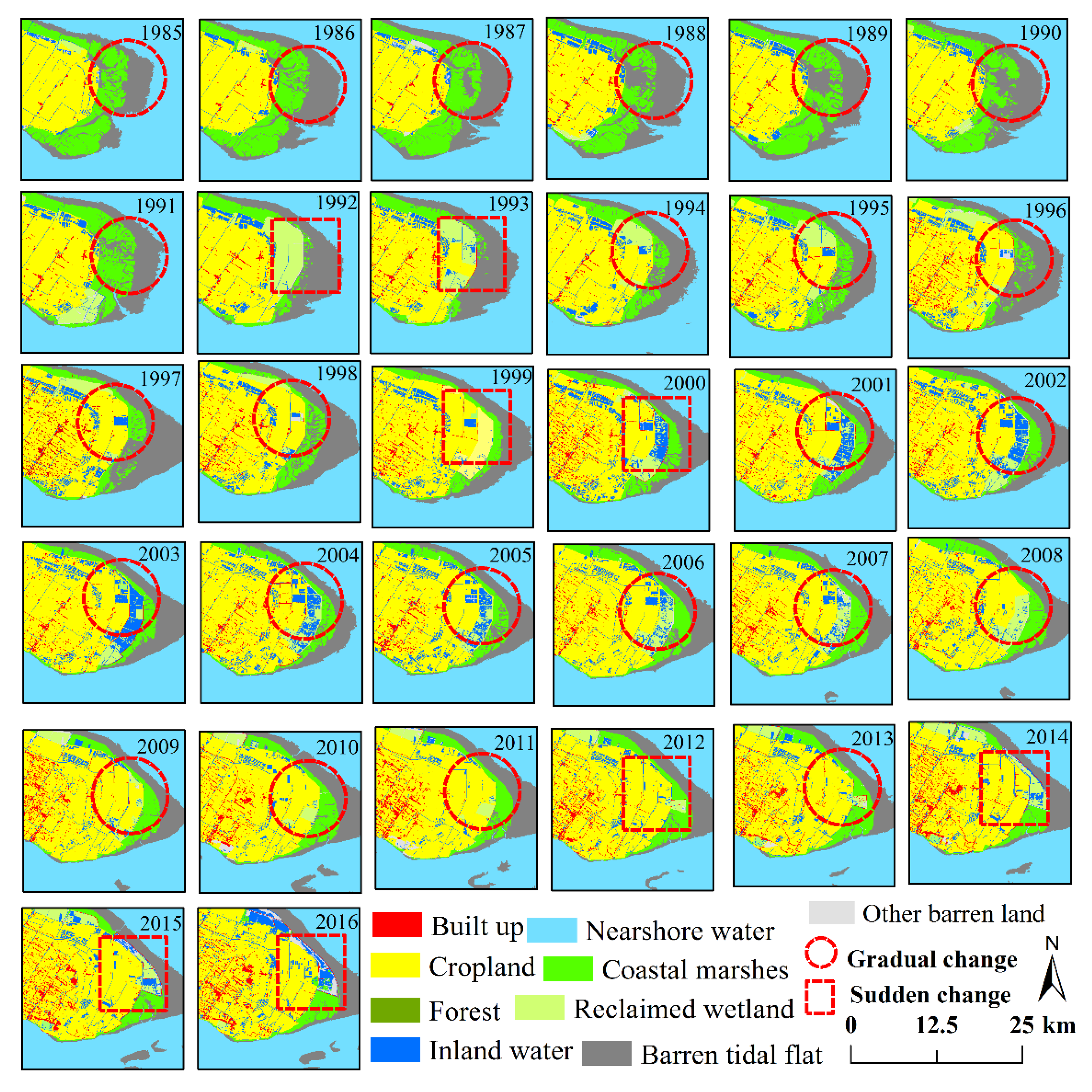Mapping Annual Land Use and Land Cover Changes in the Yangtze Estuary Region Using an Object-Based Classification Framework and Landsat Time Series Data
Abstract
1. Introduction
2. Materials and Methods
2.1. Study Area
2.2. Landsat Image Preprocessing
2.2.1. Image Selection
2.2.2. Atmospheric Correction and Geometric Correction
2.2.3. Gap Filling and Cloud Removal
2.2.4. Calculation of Spectral Indices
2.3. Classification Scheme
2.4. Object-Based Classification Framework
2.5. Multi-Temporal Segmentation
2.6. LULC Classification
2.6.1. Object-Based Hierarchical Classification Stage
2.6.2. Updating and Backdating Stage
2.7. Accuracy Assessment
3. Results
3.1. Accuracy Assessment of the LULC Maps
3.2. Long-Term LULC Dynamics
3.3. Monitoring Gradual Changes with Long-Term Time Series of LULC Products
4. Discussion
4.1. Advantages and Disadvantages of the Proposed Framework
4.2. Implications for Ecological Restoration
5. Conclusions and Future Work
Supplementary Materials
Author Contributions
Funding
Acknowledgments
Conflicts of Interest
References
- Zhao, B.; Yan, Y.; Guo, H.; He, M.; Gu, Y.; Li, B. Monitoring rapid vegetation succession in estuarine wetland using time series MODIS-based indicators: An application in the Yangtze River Delta area. Ecol. Indic. 2009, 9, 346–356. [Google Scholar] [CrossRef]
- Tian, B.; Wu, W.; Yang, Z.; Zhou, Y. Drivers, trends, and potential impacts of long-term coastal reclamation in China from 1985 to 2010. Estuar. Coast. Shelf Sci. 2016, 170, 83–90. [Google Scholar] [CrossRef]
- Ai, J.; Gao, W.; Gao, Z.; Shi, R.; Zhang, C. Phenology-based Spartina alterniflora mapping in coastal wetland of the Yangtze Estuary using time series of GaoFen satellite no. 1 wide field of view imagery. J. Appl. Remote Sens. 2017, 11, 026020. [Google Scholar] [CrossRef]
- Chakraborty, A.; Sachdeva, K.; Joshi, P.K. Mapping long-term land use and land cover change in the central Himalayan region using a tree-based ensemble classification approach. Appl. Geogr. 2016, 74, 136–150. [Google Scholar] [CrossRef]
- Vogelmann, J.E.; Gallant, A.L.; Shi, H.; Zhu, Z. Perspectives on monitoring gradual change across the continuity of Landsat sensors using time-series data. Remote Sens. Environ. 2016, 185, 258–270. [Google Scholar] [CrossRef]
- Klemas, V.V. Coastal and environmental remote sensing from unmanned aerial vehicles: An overview. J. Coast. Res. 2015, 31, 1260–1267. [Google Scholar] [CrossRef]
- Sun, C.; Liu, Y.; Zhao, S.; Zhou, M.; Yang, Y.; Li, F. Classification mapping and species identification of salt marshes based on a short-time interval NDVI time-series from HJ-1 optical imagery. Int. J. Appl. Earth Obs. Geoinf. 2016, 45, 27–41. [Google Scholar] [CrossRef]
- Gray, P.; Ridge, J.; Poulin, S.; Seymour, A.; Schwantes, A.; Swenson, J.; Johnston, D. Integrating drone imagery into high resolution satellite remote sensing assessments of estuarine environments. Remote Sens. 2018, 10, 1257. [Google Scholar] [CrossRef]
- Li, W.; Gong, P. Continuous monitoring of coastline dynamics in western Florida with a 30-year time series of Landsat imagery. Remote Sens. Environ. 2016, 179, 196–209. [Google Scholar] [CrossRef]
- Wulder, M.A.; White, J.C.; Goward, S.N.; Masek, J.G.; Irons, J.R.; Herold, M.; Woodcock, C.E. Landsat continuity: Issues and opportunities for land cover monitoring. Remote Sens. Environ. 2008, 112, 955–969. [Google Scholar] [CrossRef]
- Adam, E.; Mutanga, O.; Odindi, J.; Abdel-Rahman, E.M. Land-use/cover classification in a heterogeneous coastal landscape using RapidEye imagery: Evaluating the performance of random forest and support vector machines classifiers. Int. J. Remote Sens. 2014, 35, 3440–3458. [Google Scholar] [CrossRef]
- Tran, H.; Tran, T.; Kervyn, M. Dynamics of land cover/land use changes in the Mekong Delta, 1973–2011: A remote sensing analysis of the Tran Van Thoi District, Ca Mau Province, Vietnam. Remote Sens. 2015, 7, 2899–2925. [Google Scholar] [CrossRef]
- Zhang, B.; Zhang, Q.; Feng, C.; Feng, Q.; Zhang, S. Understanding Land Use and Land Cover Dynamics from 1976 to 2014 in Yellow River Delta. Land 2017, 6, 20. [Google Scholar] [CrossRef]
- Shi, G.; Jiang, N.; Yao, L. Land use and cover change during the rapid economic growth period from 1990 to 2010: A case study of shanghai. Sustainability 2018, 10, 426. [Google Scholar] [CrossRef]
- Kesgin, B.; Nurlu, E. Land cover changes on the coastal zone of Candarli Bay, Turkey using remotely sensed data. Environ. Monit. Assess. 2009, 157, 89–96. [Google Scholar] [CrossRef] [PubMed]
- Dearing, J.; Braimoh, A.; Reenberg, A.; Turner, B.; van der Leeuw, S. Complex land systems: The need for long time perspectives to assess their future. Ecol. Soc. 2010, 15, 21. [Google Scholar] [CrossRef]
- Lu, D.; Weng, Q. A survey of image classification methods and techniques for improving classification performance. Int. J. Remote Sens. 2007, 28, 823–870. [Google Scholar] [CrossRef]
- Gómez, C.; White, J.C.; Wulder, M.A. Optical remotely sensed time series data for land cover classification: A review. ISPRS J. Photogramm. Remote Sens. 2016, 116, 55–72. [Google Scholar] [CrossRef]
- Toure, S.I.; Stow, D.A.; Shih, H.C.; Weeks, J.; Lopez-Carr, D. Land cover and land use change analysis using multi-spatial resolution data and object-based image analysis. Remote Sens. Environ. 2018, 210, 259–268. [Google Scholar] [CrossRef]
- Souza-Filho, P.; Nascimento, W.; Santos, D.; Weber, E.; Silva, R.; Siqueira, J. A GEOBIA approach for multitemporal land-cover and land-use change analysis in a tropical watershed in the southeastern Amazon. Remote Sens. 2018, 10, 1683. [Google Scholar] [CrossRef]
- Ma, L.; Li, M.; Ma, X.; Cheng, L.; Du, P.; Liu, Y. A review of supervised object-based land-cover image classification. ISPRS J. Photogramm. Remote Sens. 2017, 130, 277–293. [Google Scholar] [CrossRef]
- Chen, Y.; Zhou, Y.N.; Ge, Y.; An, R.; Chen, Y. Enhancing land cover mapping through integration of pixel-based and object-based classifications from remotely sensed imagery. Remote Sens. 2018, 10, 77. [Google Scholar] [CrossRef]
- Benz, U.C.; Hofmann, P.; Willhauck, G.; Lingenfelder, I.; Heynen, M. Multi-resolution, object-oriented fuzzy analysis of remote sensing data for GIS-ready information. ISPRS J. Photogramm. Remote Sens. 2004, 58, 239–258. [Google Scholar] [CrossRef]
- Myint, S.W.; Gober, P.; Brazel, A.; Grossman-Clarke, S.; Weng, Q. Per-pixel vs. object-based classification of urban land cover extraction using high spatial resolution imagery. Remote Sens. Environ. 2011, 115, 1145–1161. [Google Scholar] [CrossRef]
- Ouyang, Z.T.; Zhang, M.Q.; Xie, X.; Shen, Q.; Guo, H.Q.; Zhao, B. A comparison of pixel-based and object-oriented approaches to VHR imagery for mapping saltmarsh plants. Ecol. Inf. 2011, 6, 136–146. [Google Scholar] [CrossRef]
- Tehrany, M.S.; Pradhan, B.; Jebuv, M.N. A comparative assessment between object and pixel-based classification approaches for land use/land cover mapping using SPOT 5 imagery. Geocarto Int. 2014, 29, 351–369. [Google Scholar] [CrossRef]
- Ma, T.; Li, X.; Bai, J.; Cui, B. Tracking three decades of land use and land cover transformation trajectories in China’s large river deltas. Land Degrad. Dev. 2019, 30, 799–810. [Google Scholar] [CrossRef]
- Di, X.; Hou, X.; Wang, Y.; Wu, L. Spatial-temporal characteristics of land use intensity of coastal zone in China during 2000–2010. Chin. Geogr. Sci. 2015, 25, 51–61. [Google Scholar] [CrossRef]
- Xie, Y.; Zhang, A.; Welsh, W. Mapping wetlands and phragmites using publically available remotely sensed images. Photogramm. Eng. Remote Sci. 2015, 81, 69–78. [Google Scholar] [CrossRef]
- Moffett, K.; Nardin, W.; Silvestri, S.; Wang, C.; Temmerman, S. Multiple stable states and catastrophic shifts in coastal wetlands: Progress, challenges, and opportunities in validating theory using remote sensing and other methods. Remote Sens. 2015, 7, 10184–10226. [Google Scholar] [CrossRef]
- Ai, J.; Gao, W.; Gao, Z.; Shi, R.; Zhang, C.; Liu, C. Integrating pan-sharpening and classifier ensemble techniques to map an invasive plant (Spartina alterniflora) in an estuarine wetland using Landsat 8 imagery. J. Appl. Remote Sens. 2016, 10, 026001. [Google Scholar] [CrossRef]
- Li, B.; Liao, C.H.; Zhang, X.D.; Chen, H.L.; Wang, Q.; Chen, Z.Y.; Cheng, X.L. Spartina alterniflora invasions in the Yangtze River estuary, China: An overview of current status and ecosystem effects. Ecol. Eng. 2009, 35, 511–520. [Google Scholar] [CrossRef]
- Sexton, J.O.; Urban, D.L.; Donohue, M.J.; Song, C. Long-term land cover dynamics by multi-temporal classification across the Landsat-5 record. Remote Sens. Environ. 2013, 128, 246–258. [Google Scholar] [CrossRef]
- Cooley, T.; Anderson, G.P.; Felde, G.W.; Hoke, M.L.; Ratkowski, A.J.; Chetwynd, J.H.; Bernstein, L.S. FLAASH, a MODTRAN4-based atmospheric correction algorithm, its application and validation. In Proceedings of the IEEE International Geoscience and Remote Sensing Symposium, Toronto, ON, Canada, 24–28 June 2002. [Google Scholar]
- Garcia, D. Robust smoothing of gridded data in one and higher dimensions with missing values. Comput. Stat. Data Anal. 2010, 54, 1167–1178. [Google Scholar] [CrossRef] [PubMed]
- Zhang, L.; Weng, Q. Annual dynamics of impervious surface in the Pearl River Delta, China, from 1988 to 2013, using time series Landsat imagery. ISPRS J. Photogramm. Remote Sens. 2016, 113, 86–96. [Google Scholar] [CrossRef]
- Gómez, C.; White, J.C.; Wulder, M.A.; Alejandro, P. Integrated object-based spatiotemporal characterization of forest change from an annual time series of Landsat image composites. Can. J. Remote Sens. 2015, 41, 271–292. [Google Scholar] [CrossRef]
- Chen, J.; Zhu, X.; Vogelmann, J.E.; Gao, F.; Jin, S. A simple and effective method for filling gaps in Landsat ETM+ SLC-off images. Remote Sens. Environ. 2011, 115, 1053–1064. [Google Scholar] [CrossRef]
- Liu, H.Q.; Huete, A. A feedback based modification of the NDVI to minimize canopy background and atmospheric noise. IEEE Trans. Geosci Remote Sens. 1995, 33, 457–465. [Google Scholar] [CrossRef]
- Xu, H. Modification of normalised difference water index (NDWI) to enhance open water features in remotely sensed imagery. Int. J. Remote Sens. 2006, 27, 3025–3033. [Google Scholar] [CrossRef]
- Zha, Y.; Gao, J.; Ni, S. Use of normalized difference built-up index in automatically mapping urban areas from TM imagery. Int. J. Remote Sens. 2003, 24, 583–594. [Google Scholar] [CrossRef]
- Yuan, F.; Sawaya, K.E.; Loeffelholz, B.C.; Bauer, M.E. Land cover classification and change analysis of the Twin Cities (Minnesota) Metropolitan Area by multitemporal remote sensing. Remote Sens. Environ. 2005, 98, 317–328. [Google Scholar] [CrossRef]
- Gong, P.; Niu, Z.; Cheng, X.; Zhao, K.; Zhou, D.; Guo, J.; Ying, Q. China’s wetland change (1990–2000) determined by remote sensing. Sci. China Earth Sci. 2010, 53, 1036–1042. [Google Scholar] [CrossRef]
- Baatz, M.; Schäpe, A. Multiresolution segmentation—An optimization approach for high quality multi-scale image segmentation. In Angewandte Geographische Informations-Verarbeitung XII; Strobl, J., Blaschke, T., Griesebner, G., Eds.; Wichmann Verlag: Karlsruhe, Germany, 2000. [Google Scholar]
- Blaschke, T. Object-based contextual image classification built on image segmentation. In Proceedings of the IEEE Workshop on Advances in Techniques for Analysis of Remotely Sensed Data, Greenbelt, MD, USA, 27–28 October 2003. [Google Scholar]
- eCognition. eCognition Developer 8.7 User Guide; Trimble Documentation; eCognition: München, Germany, 2011. [Google Scholar]
- Drǎguţ, L.; Tiede, D.; Levick, S.R. ESP: A tool to estimate scale parameter for multiresolution image segmentation of remotely sensed data. Int. J. Geogr. Inf. Sci. 2010, 24, 859–871. [Google Scholar] [CrossRef]
- Yu, W.; Zhou, W.; Qian, Y.; Yan, J. A new approach for land cover classification and change analysis: Integrating backdating and an object-based method. Remote Sens. Environ. 2016, 177, 37–47. [Google Scholar] [CrossRef]
- Linke, J.; McDermid, G.J. Monitoring landscape change in multi-use west-central Alberta, Canada using the disturbance-inventory framework. Remote Sens. Environ. 2012, 125, 112–124. [Google Scholar] [CrossRef]
- Linke, J.; McDermid, G.J.; Laskin, D.N.; McLane, A.J.; Pape, A.; Cranston, J.; Hall-Beyer, M.; Franklin, S.E. A disturbance-inventory framework for flexible and reliable landscape monitoring. Photogramm. Eng. Remote Sci. 2009, 75, 981–995. [Google Scholar] [CrossRef]
- Cochran, W.G. Sampling Techniques, 3rd ed.; Wiley: New York, NY, USA, 1977. [Google Scholar]
- Olofsson, P.; Foody, G.M.; Herold, M.; Stehman, S.V.; Woodcock, C.E.; Wulder, M.A. Good practices for estimating area and assessing accuracy of land change. Remote Sens. Environ. 2014, 148, 42–57. [Google Scholar] [CrossRef]
- Congalton, R.G.; Green, K. Assessing the Accuracy of Remotely Sensed Data: Principles and Practices; CRC Press: Boca Raton, FL, USA, 2008. [Google Scholar]
- Jozdani, S.E.; Johnson, B.A.; Chen, D. Comparing deep neural networks, ensemble classifiers, and support vector machine algorithms for object-based urban land use/land cover classification. Remote Sens. 2019, 11, 1713. [Google Scholar] [CrossRef]
- McDermid, G.J.; Linke, J.; Pape, A.D.; Laskin, D.N.; McLane, A.J.; Franklin, S.E. Object-based approaches to change analysis and thematic map update: Challenges and limitations. Can. J. Remote Sens. 2008, 34, 462–466. [Google Scholar] [CrossRef]
- Liu, X.; Hu, G.; Chen, Y.; Li, X.; Xu, X.; Li, S.; Wang, S. High-resolution multi-temporal mapping of global urban land using Landsat images based on the Google Earth Engine Platform. Remote Sens. Environ. 2018, 209, 227–239. [Google Scholar] [CrossRef]
- Venkatappa, M.; Sasaki, N.; Shrestha, R.P.; Tripathi, N.K.; Ma, H.O. Determination of Vegetation Thresholds for Assessing Land Use and Land Use Changes in Cambodia using the Google Earth Engine Cloud-Computing Platform. Remote Sens. 2019, 11, 1514. [Google Scholar] [CrossRef]






| Year | “Spring” | “Summer” | “Autumn” | Image for Tidal Flat Mapping | Time Assignment for Updating /Backdating |
|---|---|---|---|---|---|
| 1985 | 23/04/1984 | 19/08/1986 | 20/11/1985 | 21/02/1985 | T−5 |
| 1986 | 18/05/1987 | 19/08/1986 | 20/11/1985 | 21/02/1985 | T−4 |
| 1987 | 18/05/1987 | 03/07/1988 | 28/12/1987 | 18/05/1987 | T−3 |
| 1988 | 18/05/1987 | 03/07/1988 | 30/10/1989 | 13/01/1988 | T−2 |
| 1989 | 01/12/1989 | 11/08/1989 | 30/10/1989 | 11/08/1989 | T−1 |
| 1990 | 26/05/1990 | 14/08/1990 | 04/12/1990 | 14/08/1990 | T0 |
| 1991 | 13/04/1992 | 18/07/1992 | 20/10/1991 | 22/02/1991 | T+1 |
| 1992 | 31/05/1992 | 18/07/1992 | 20/10/1991 | 18/07/1992 | T+2 |
| 1993 | 31/03/1993 | 03/06/1993 | 20/10/1991 | 31/03/1993 | T−2 |
| 1994 | 05/05/1994 | 12/08/1995 | 16/11/1995 | 05/05/1994 | T−1 |
| 1995 | 08/05/1995 | 12/08/1995 | 16/11/1995 | 16/11/1995 | T0 |
| 1996 | 24/04/1996 | 18/09/1997 | 18/11/1996 | 24/04/1996 | T−4 |
| 1997 | 11/04/1997 | 18/09/1997 | 20/10/1997 | 11/04/1997 | T−3 |
| 1998 | 14/04/1998 | 04/08/1998 | 08/11/1998 | 08/11/1998 | T−2 |
| 1999 | 01/04/1999 | 24/09/1999 | 03/11/1999 | 08/11/1998 | T−1 |
| 2000 | 27/04/2000 | 02/09/2000 | 05/11/2000 | 02/09/2000 | T0 |
| 2001 | 21/03/2001 | 03/07/2001 | 16/11/2001 | 02/09/2000 | T+1 |
| 2002 | 08/03/2002 | 30/07/2002 | 11/11/2002 | 11/11/2002 | T+2 |
| 2003 | 08/03/2002 | 02/08/2003 | 29/10/2003 | 02/08/2003 | T−5 |
| 2004 | 11/05/2005 | 19/07/2004 | 24/11/2004 | 19/07/2004 | T−4 |
| 2005 | 11/05/2005 | 12/06/2005 | 27/11/2005 | 12/06/2005 | T−3 |
| 2006 | 20/04/2006 | 02/08/2006 | 27/11/2005 | 20/04/2006 | T−2 |
| 2007 | 07/04/2007 | 28/07/2007 | 19/11/2008 | 20/04/2006 | T−1 |
| 2008 | 11/05/2008 | 06/07/2008 | 19/11/2008 | 11/05/2008 | T0 |
| 2009 | 28/04/2009 | 19/09/2009 | 03/12/2010 | 28/04/2009 | T−4 |
| 2010 | 25/05/2010 | 20/05/2011 | 03/12/2010 | 27/12/2010 | T−3 |
| 2011 | 26/04/2011 | 20/05/2011 | 06/11/2012 | 28/04/2012 | T−2 |
| 2012 | 28/04/2012 | 29/08/2013 | 06/11/2012 | 28/04/2012 | T−1 |
| 2013 | 25/05/2013 | 29/08/2013 | 17/11/2013 | 29/08/2013 | T0 |
| 2014 | 28/05/2014 | 29/08/2013 | 04/11/2014 | 29/08/2013 | T+1 |
| 2015 | 12/03/2015 | 03/08/2015 | 03/12/2016 | 12/03/2015 | T+2 |
| 2016 | 17/05/2016 | 20/07/2016 | 03/12/2016 | 03/12/2016 | T+3 |
| Class | Description |
|---|---|
| Impervious | Built-up land, roads, transportation, residential, commercial services, industrial areas and settlements in villages |
| Cropland | Areas cultivated with crops such as rice, beans, and maize |
| Forest | Areas dominated by trees or shrubs, > 30% vegetation cover |
| Grass | Lawns and grassland |
| Inland water | Water bodies located inland |
| Coastal marshes | Saltmarsh and reclaimed marsh that was converted from saltmarsh, > 30% vegetation cover |
| Barren tidal flat | Intertidal mudflat, < 30% vegetation cover |
| Nearshore water | Estuarine water bodies beyond the coastline, shallow seawater |
| Other barren land | Barren land and transactional lands (reclaimed land) that are likely to change or be converted to other uses in the further |
| Reference Class (T0) | Initial Classified Class (Ti) | Backdating/Updating to Class | Features/Method | Reference Values of Features |
|---|---|---|---|---|
| Impervious | Cropland | Impervious | EVIave, NDBIave | EVIave < 0.2 & NDBIave > −0.06 |
| Impervious | Unused land | Impervious | EVIave, NDBIave | NDBIave > 0 |
| Cropland | Forest | Cropland | EVIave | EVIave > 0.2 |
| Cropland | Grass | Cropland | EVIave | EVIave > 0.18 |
| Cropland | Impervious | Cropland | EVIave, NDBIave | EVIave > 0.2 & NDBIave < −0.16 |
| Cropland | Inland water | Cropland | EVIave | EVIave > 0.15 |
| Forest | Cropland | Forest | Visual interpretation | - |
| Forest | Grass | Forest | Visual interpretation | - |
| Grass | Cropland | Grass | Visual interpretation | - |
| Grass | Forest | Forest | Visual interpretation | - |
| Inland water | Cropland | Inland water | MNDWIave | MNDWIave > −0.05 |
| Inland water | Unused land | Inland water | MNDWIave | MNDWIave > 0 |
| Unused land | Impervious | Unused land | Visual interpretation | - |
| Unused land | Cropland | Cropland | Visual interpretation | - |
| Unused land | Inland water | Inland water | Visual interpretation | - |
| Class/Year | 1985 | 1992 | 1998 | 2005 | 2011 | 2016 |
|---|---|---|---|---|---|---|
| Impervious | 86 | 152 | 204 | 294 | 345 | 405 |
| Cropland | 1077 | 1014 | 974 | 905 | 842 | 767 |
| Forest | 50 | 50 | 50 | 50 | 50 | 50 |
| Grass | 50 | 50 | 50 | 50 | 50 | 50 |
| Inland water | 60 | 65 | 61 | 66 | 68 | 75 |
| Coastal marshes | 50 | 50 | 50 | 50 | 50 | 50 |
| Barren tidal flat | 80 | 73 | 72 | 60 | 67 | 67 |
| Unused land | 50 | 50 | 50 | 50 | 50 | 50 |
| Total (n) | 1503 | 1504 | 1511 | 1525 | 1522 | 1514 |
© 2020 by the authors. Licensee MDPI, Basel, Switzerland. This article is an open access article distributed under the terms and conditions of the Creative Commons Attribution (CC BY) license (http://creativecommons.org/licenses/by/4.0/).
Share and Cite
Ai, J.; Zhang, C.; Chen, L.; Li, D. Mapping Annual Land Use and Land Cover Changes in the Yangtze Estuary Region Using an Object-Based Classification Framework and Landsat Time Series Data. Sustainability 2020, 12, 659. https://doi.org/10.3390/su12020659
Ai J, Zhang C, Chen L, Li D. Mapping Annual Land Use and Land Cover Changes in the Yangtze Estuary Region Using an Object-Based Classification Framework and Landsat Time Series Data. Sustainability. 2020; 12(2):659. https://doi.org/10.3390/su12020659
Chicago/Turabian StyleAi, Jinquan, Chao Zhang, Lijuan Chen, and Dajun Li. 2020. "Mapping Annual Land Use and Land Cover Changes in the Yangtze Estuary Region Using an Object-Based Classification Framework and Landsat Time Series Data" Sustainability 12, no. 2: 659. https://doi.org/10.3390/su12020659
APA StyleAi, J., Zhang, C., Chen, L., & Li, D. (2020). Mapping Annual Land Use and Land Cover Changes in the Yangtze Estuary Region Using an Object-Based Classification Framework and Landsat Time Series Data. Sustainability, 12(2), 659. https://doi.org/10.3390/su12020659






